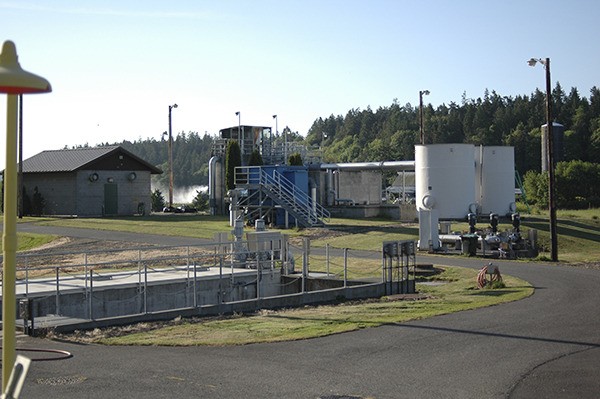Correction: Clallam PUD will not be presenting to Clallam County Commissioners about the amended facilities plan for the Urban Growth Area. The Wednesday, May 21, edition, incorrectly stated they would do this by the end of May.
Clallam County officials continue to explore the Urban Growth Area (UGA) in Carlsborg and the need for either its own sewer treatment facility or the use of Sequim’s existing facility.
Despite the multi-year process thus far, county officials still anticipate having a sewage system established and running by end of 2015.
By the end of the month an amended facility plan, including the recommendation to pump UGA sewage to the Sequim facility, will be presented by county public works officials to the board of county commissioners for final review, Community Development and Senior Planner Dennis Lefevre said.
The Department of Ecology also will have to approve the amended plan, however the review process is expected to be fairly quick since the Department of Ecology already has addressed the majority of the work needed in the original facilities plan.
The latest 20-year life cycle cost comparison presented last month by county officials, which includes the operation, maintenance and capital costs, suggests nearly $700,000 annual savings are made if a separate Carlsborg water reclamation facility (WRF) is deemed unnecessary.
Thus, within a 20-year life cycle it’s estimated more than $9 million is saved by utilizing Sequim’s WRF.
“The preliminary recommendation will be to pump to Sequim,” Public Works administrative director Bob Martin said. “It’s a cheaper, quicker and more reliable option.”
To move ahead with the Sequim alternative a conveyance system, including a shared sewage collection line, pressure line and a pump station are needed, Martin explained.
Although using existing infrastructure in Sequim is seemingly more economic and reliable, the flip-side is reduced local control for Carlsborg residents.
“We can make suggestions, but the county commissioners have the final say,” Carlsborg Community Advisory Council (CCAC) chairman Troye Jarmuth said. “It’s our hope and intention that everyone living within the UGA is provided with reasonable and achievable rates.”
Throughout the sewer project planning process the CCAC spent many months putting together an incentive program to help reduce costs for UGA residents and promote early connection to the future system, Jarmuth explained.
To entice UGA residents to join the shared sewer system sooner rather than later the county hopes to offer a lowered initial connection cost if multiple homes are connected at the same time and reduced rates for the first couple of years.
“On average we’re estimating it will cost about $63-$77 per month,” County Commissioner Jim McEntire said at a CCAC meeting. “We’re going to do everything we can to make it attractive for people to connect early.”
In addition to the basic infrastructure needed to connect to a central sewage system, water rights and water reuse options have been an ongoing concern. Because the UGA is within part of the Water Resource Inventory Area “water conservation and reuse is a high priority in the valley (Dungeness River valley),” according to the Sewer Facilities Plan.
“A lot of effort went into evaluating questions revolving water concerns,” Martin said.
To help alleviate concerns Pacific Groundwater Group (PGG) was hired in February by Clallam County officials to review the water rights held by Clallam PUD and compare existing water rights and system capacities with the predicted future demand.
Eventually, based on PGG’s research, Clallam County and the PUD will need to rely on their “Interlocal Agreement for future water-supply planning, possession of additional water rights and water-rights mitigation,” but not until about 2054.
In either case (Carlsborg or Sequim alternatives), Martin reassured that they will be compensating stream and surface water impact by recharging the aquifer.
Since PGG’s research the water concerns primarily have been addressed, but the next big challenge if the Sequim facility is favored, will be the transportation of UGA wastewater to Sequim for treatment, Jarmuth explained.
To explore the various routes for a sanitary sewer conveyance system a civil engineering and land surveying company, Zenovic and Associates Inc., submitted a report with analysis of potential conveyance routes between the UGA and Sequim treatment facility. Based on its findings, the recommended sewage route is along Carlsborg Road to Smithfield Road to Mill Road to U.S. Highway 101 to Washington Street and eventually to the Sequim WRF.
Zenovic and Associates recommend this route because of the “low risk factor and relatively minimal cost increase compared with other options.”
Undoubtably the planning process for a shared sewage system for the Carlsborg and greater UGA is still under way, but a final decision isn’t far off.
Facilities Plan, Life Cycle Cost Comparison
Facility Sequim alternative Carlsborg alternative
Initial system (2016-2030)
Carlsborg Collection System $4,754,000 $4,817,000
Lift station, Conveyance, Wastewater
Reclamation Facility Capacity, Sequim
Capital Improvement Program $6,850,000
Carlsborg Wastewater Reclamation Facility $10,650,000
Average Operations/
Maintenance (2016-2030) $323,000 (per year) $359,000 (per year)
15-Year Life Cycle Cost
– Initial System $16,449,000 $20,852,000
Additional Systems to Serve 2050 Flows
Carlsborg Collection System $3,040,000 $3,040,000
WRF Capacity, Sequim CIP,
Sequim Collection System
Improvements $5,262,000
Carlsborg Wastewater Reclamation Facility $13,610,000
Average Operations/
Maintenance (2030-2050) $675,000 (per year) $728,000 (per year)
20-Year Life Cycle Cost
(2030-2050) $21,802,000 $31,210,000
— Statistics from Carlsborg Urban Growth Area Sewer Project Update presentation, April 28
Reach Alana Linderoth at alinderoth@sequimgazette.com.



